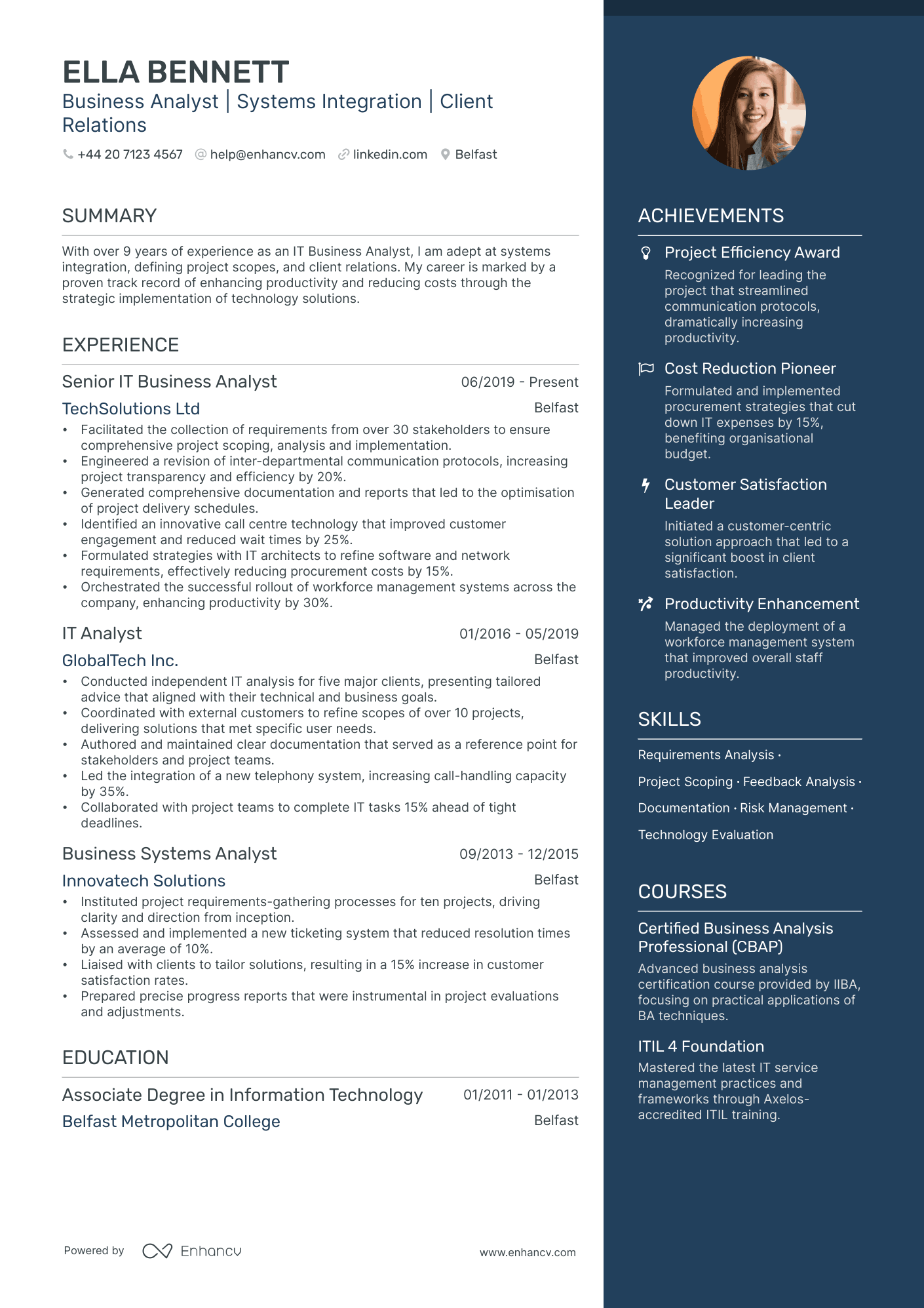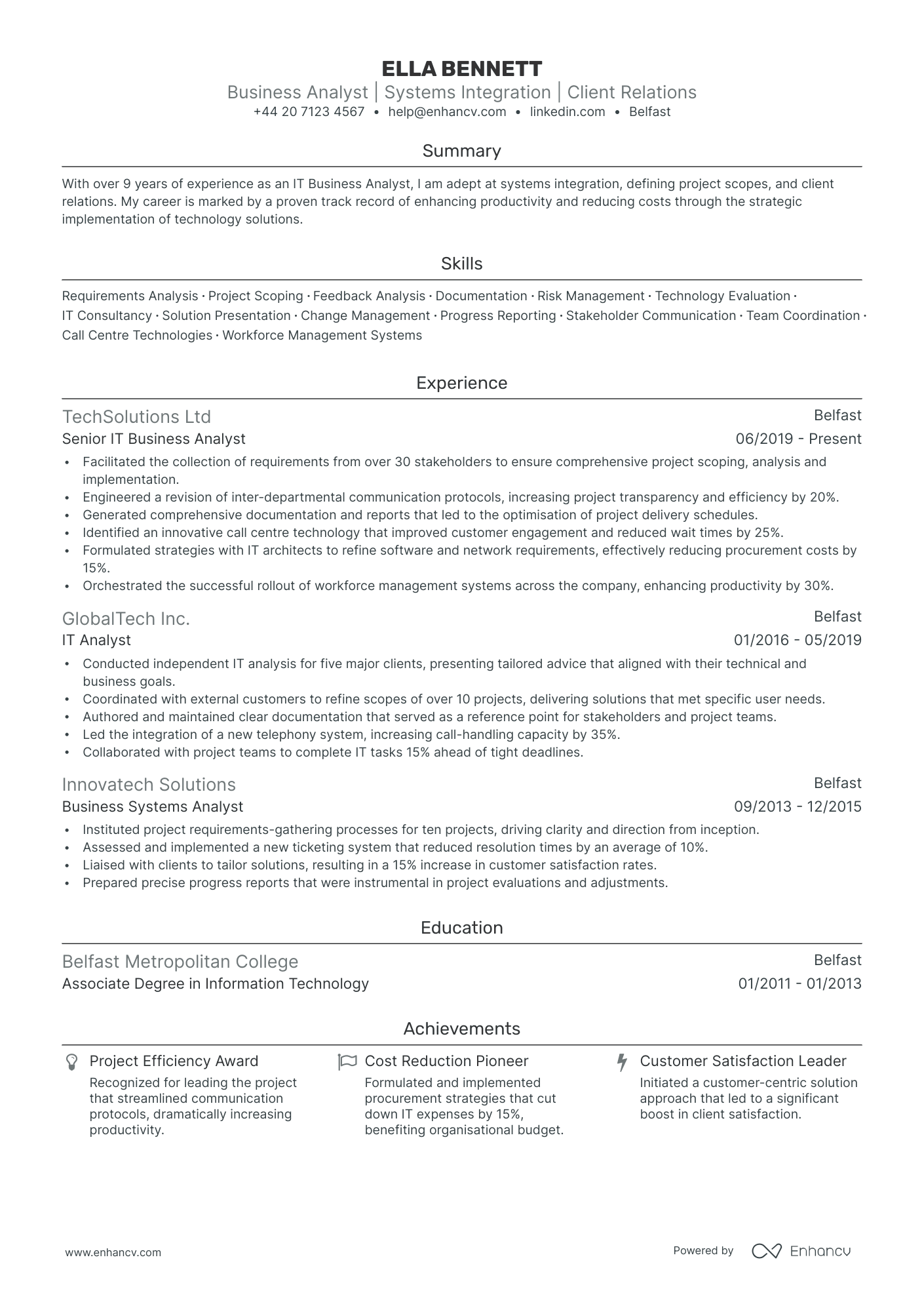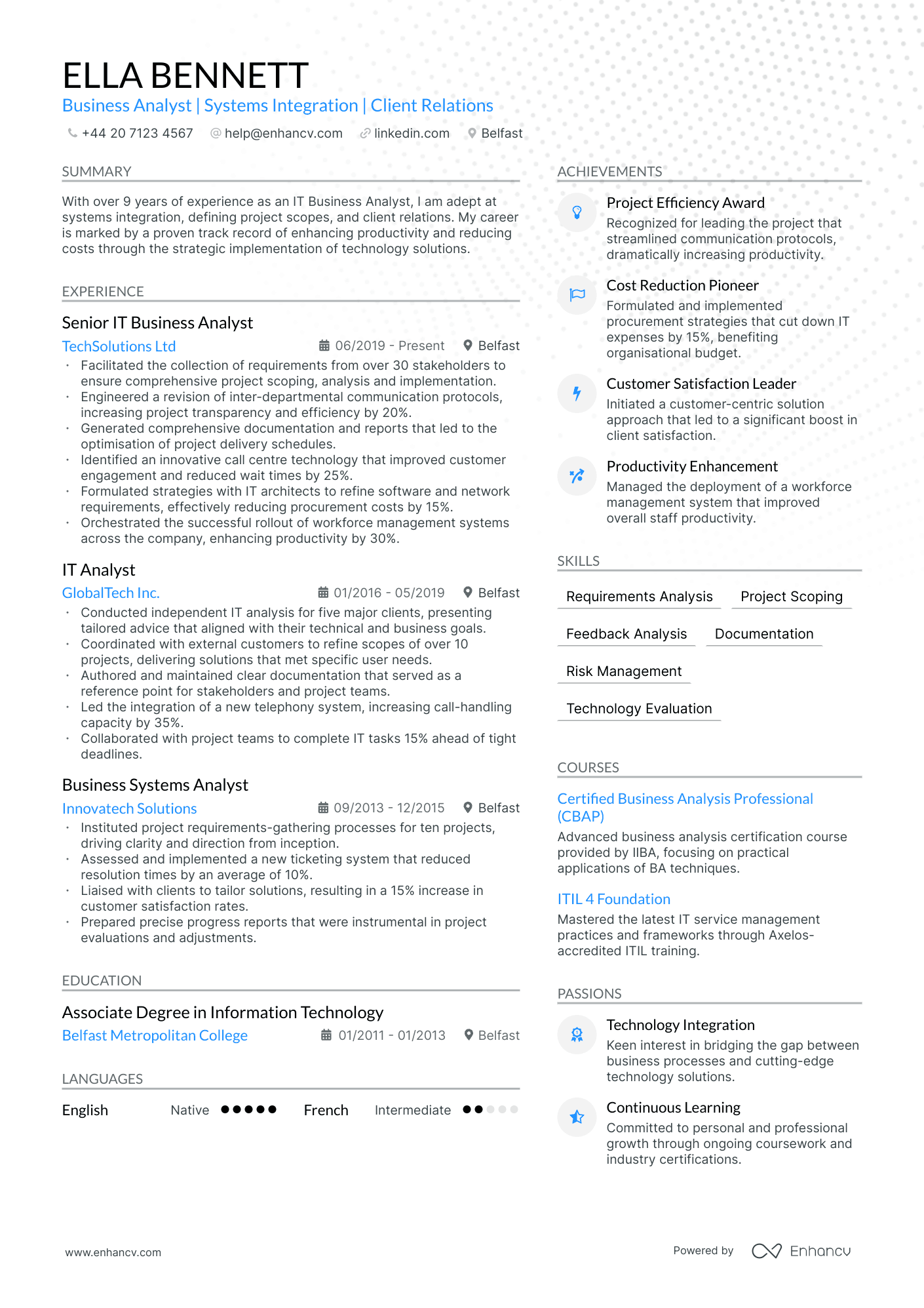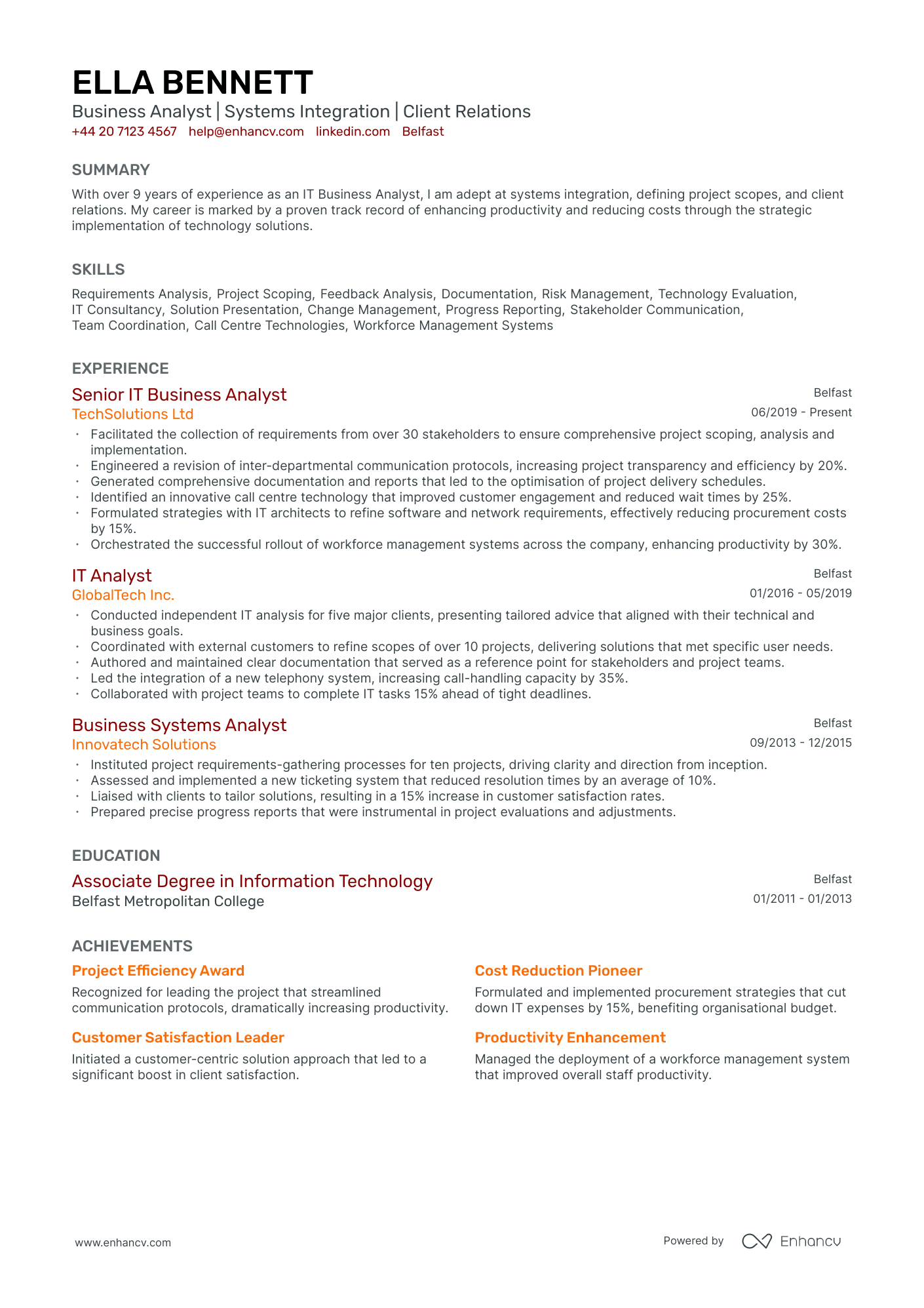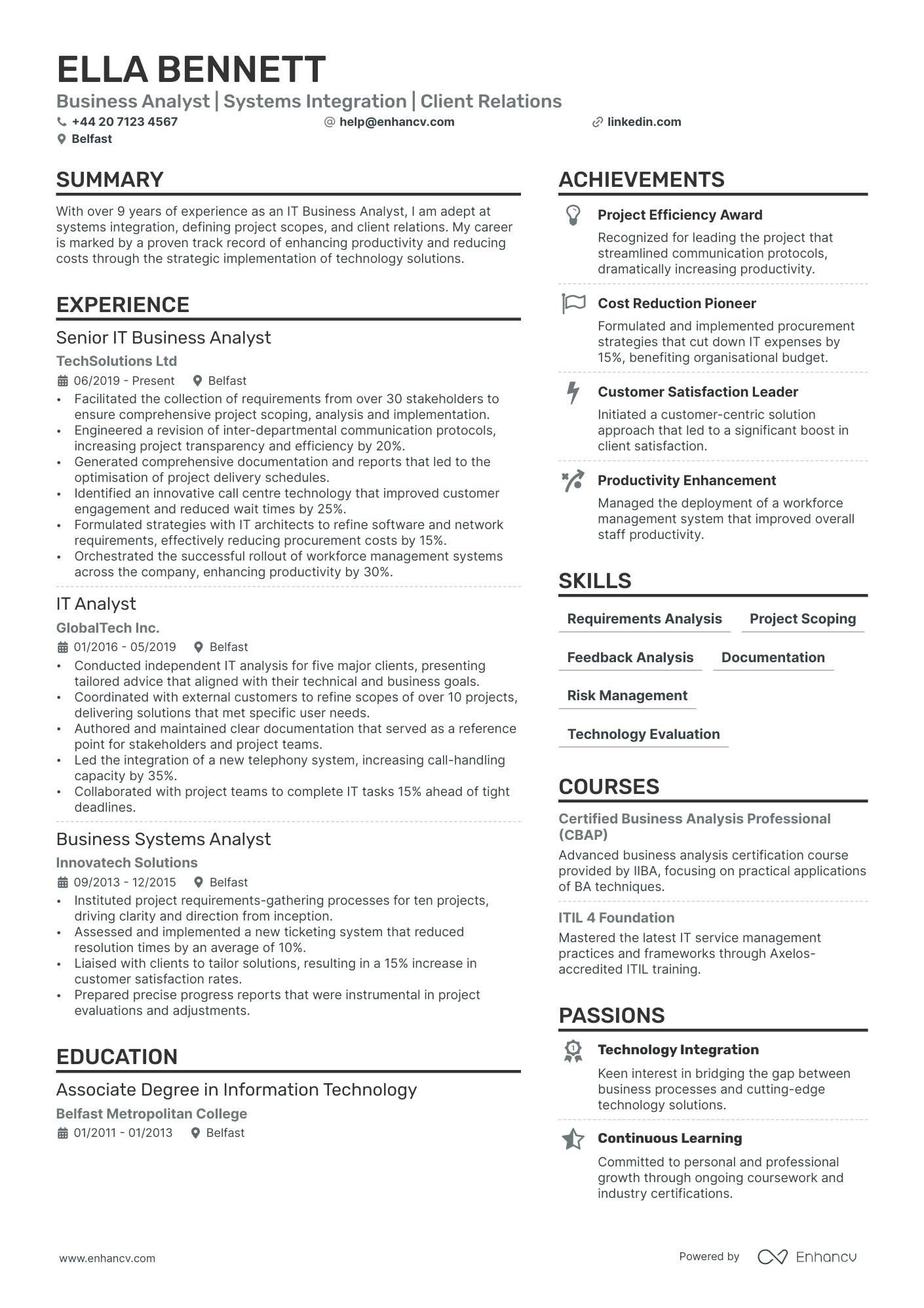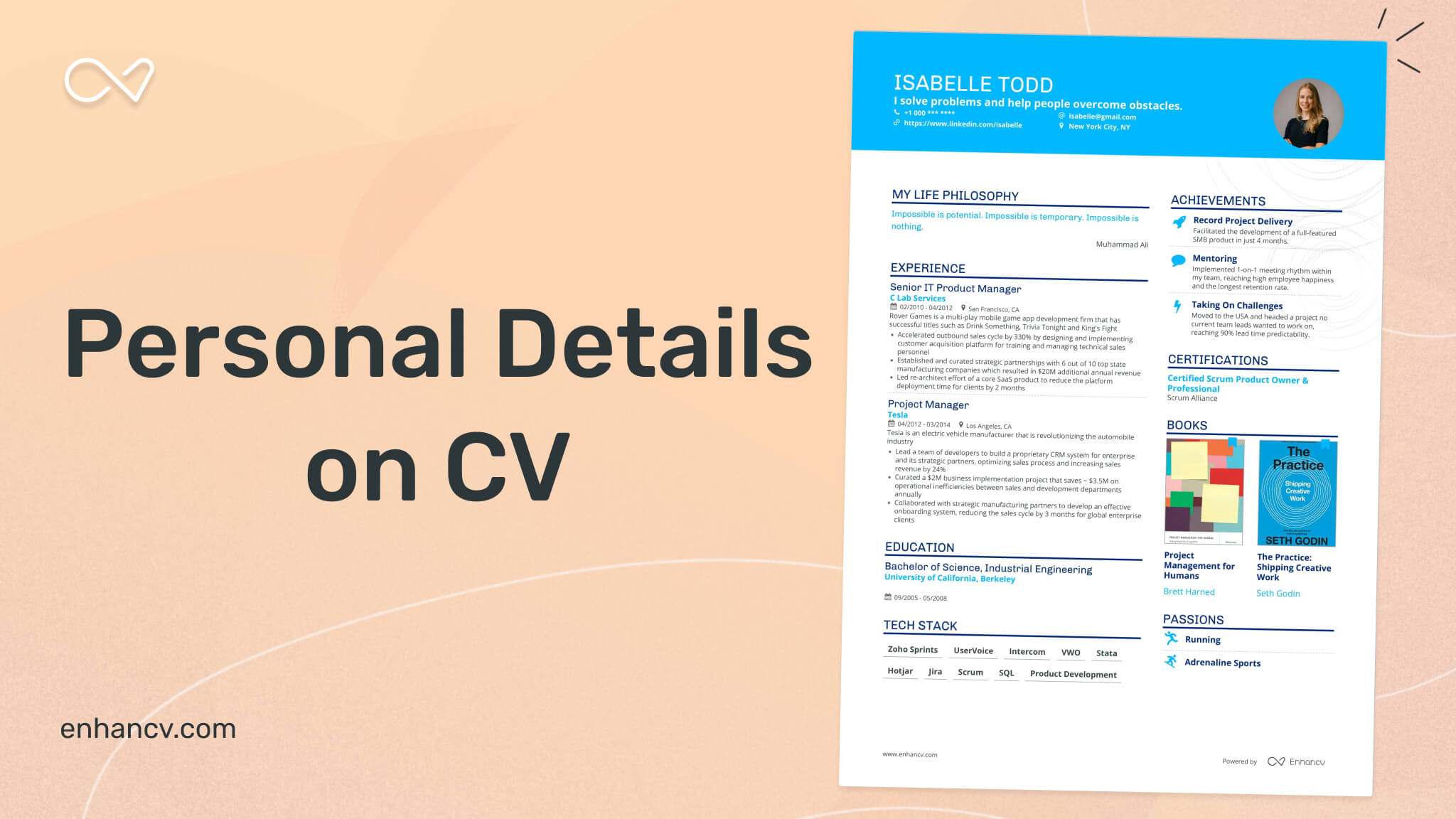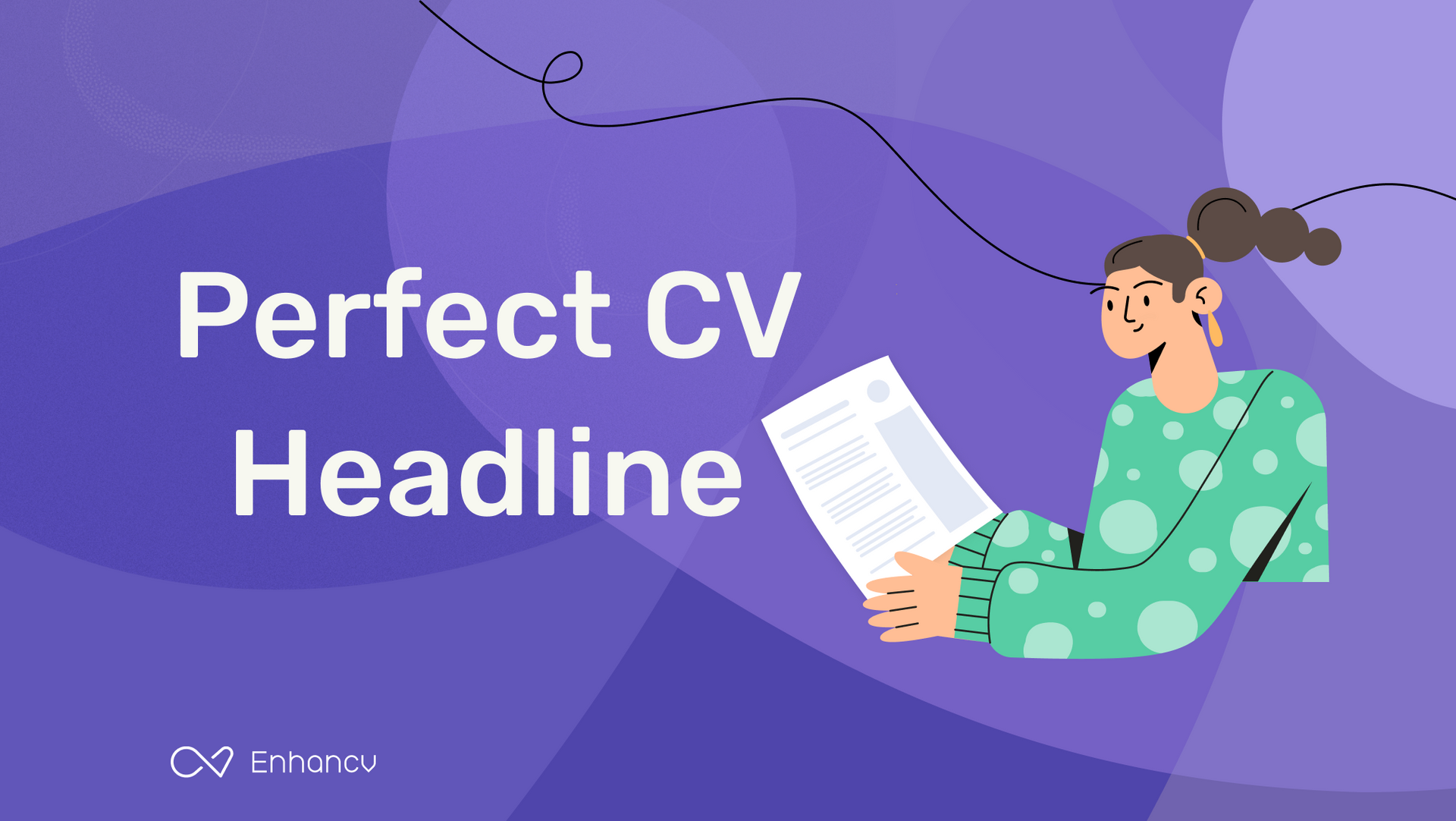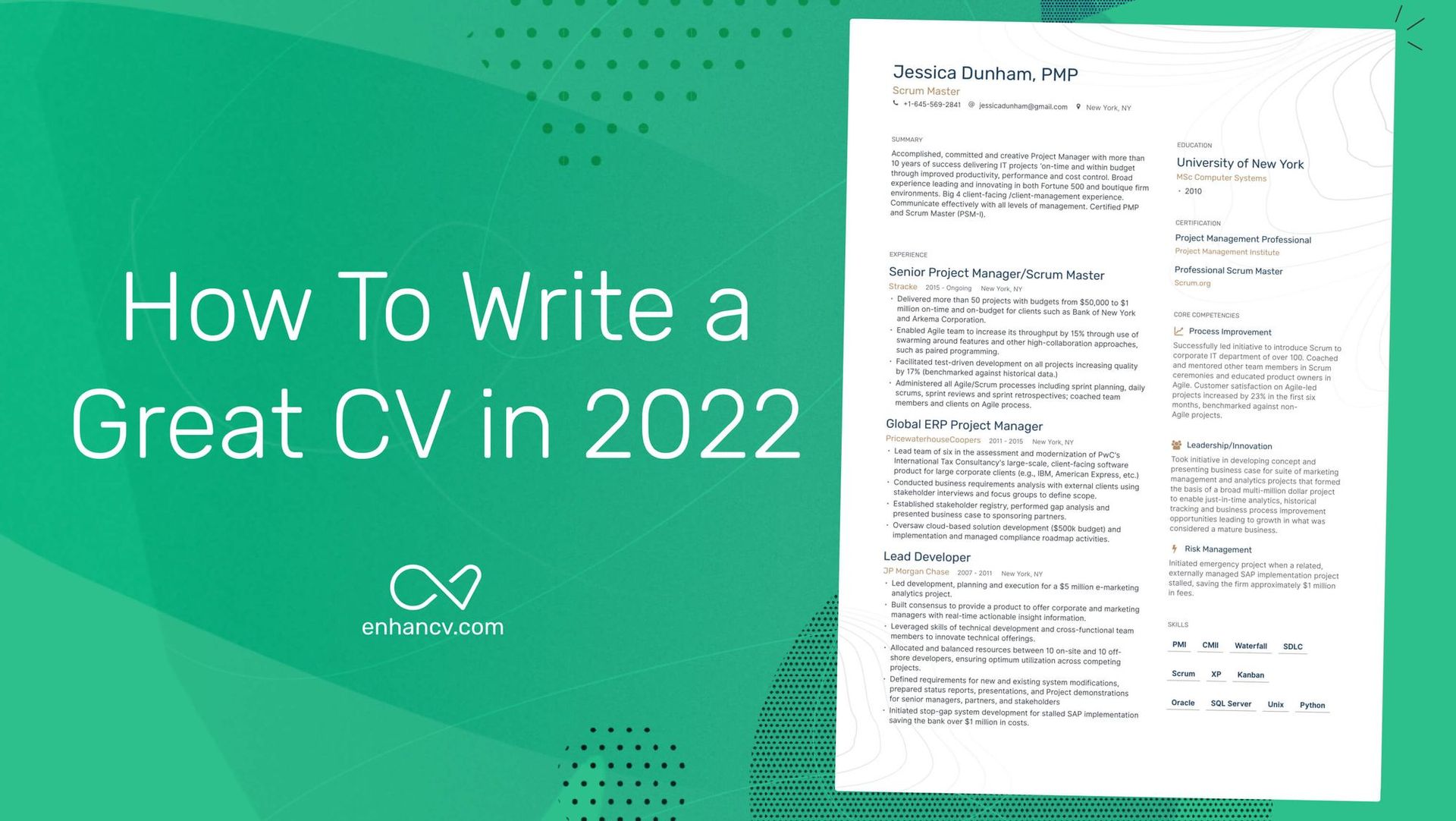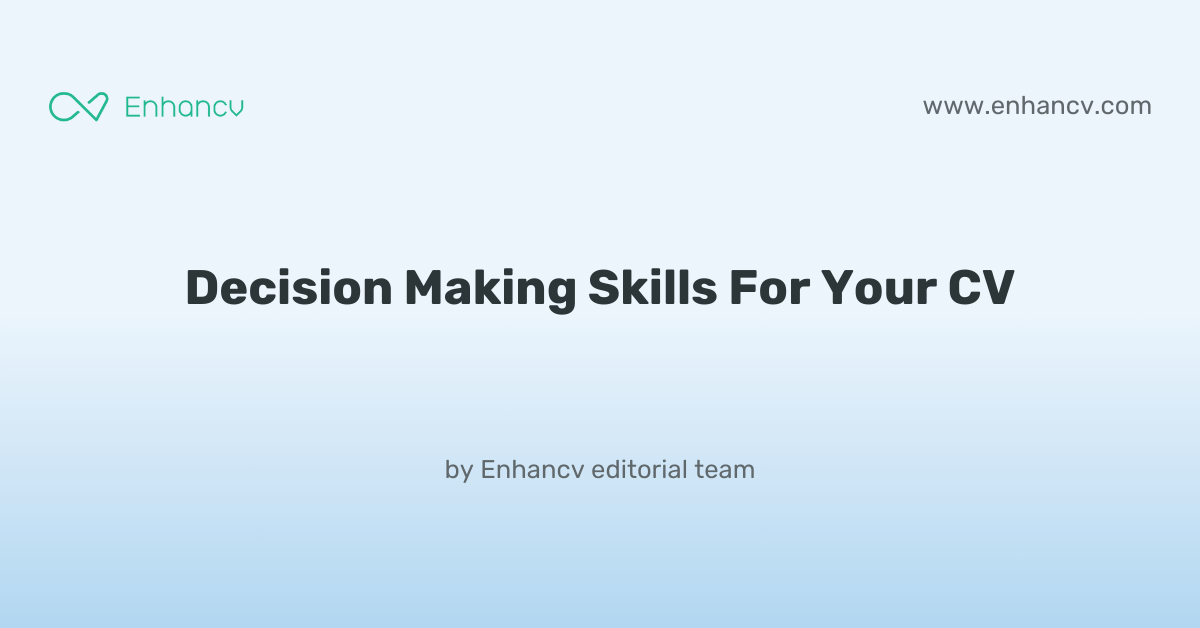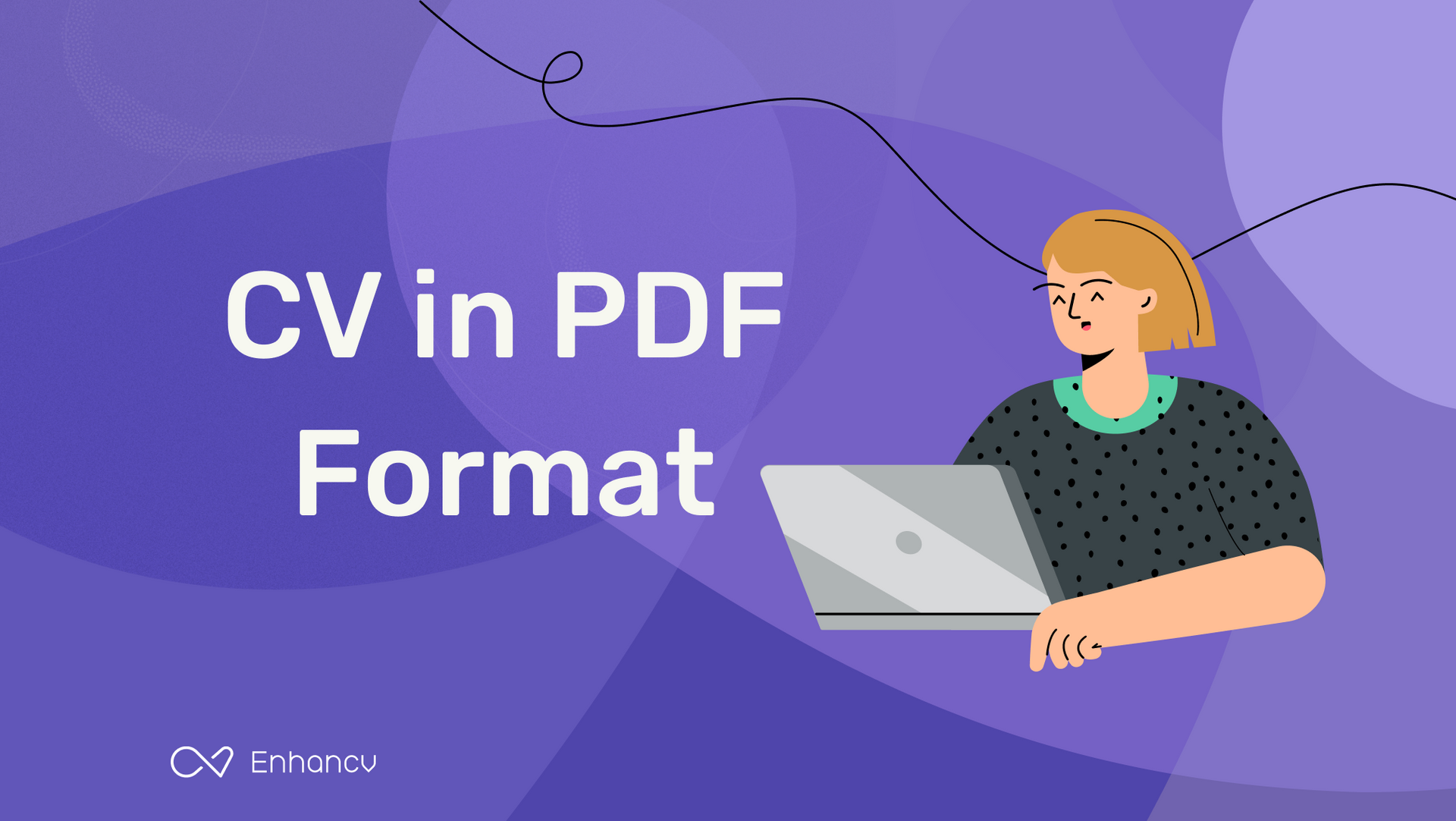One CV challenge you might face as an IT business analyst is effectively showcasing your technical skills and business acumen to stand out in a competitive job market. Our comprehensive guide provides tailored strategies to help you highlight your unique blend of IT expertise and analytical prowess, ensuring your CV makes a lasting impression on potential employers.
- Answer job requirements with your it business analyst CV and experience;
- Curate your academic background and certificates, following industry-leading CV examples;
- Select from +10 niche skills to match the ideal candidate profile
- Write a more succinct experience section that consists of all the right details.
Do you need more specific insights into writing your it business analyst CV? Our guides focus on unique insights for each individual role:
How complex should the format of your it business analyst CV be?
Perhaps, you decided to use a fancy font and plenty of colours to ensure your it business analyst CV stands out amongst the pile of other candidate profiles. Alas - this may confuse recruiters. By keeping your format simple and organising your information coherently, you'll ultimately make a better impression. What matters most is your experience, while your CV format should act as complementary thing by:- Presenting the information in a reverse chronological order with the most recent of your jobs first. This is done so that your career history stays organised and is aligned to the role;
- Making it easy for recruiters to get in touch with you by including your contact details in the CV header. Regarding the design of your CV header, include plenty of white space and icons to draw attention to your information. If you're applying for roles in the UK, don't include a photo, as this is considered a bad practice;
- Organising your most important CV sections with consistent colours, plenty of white space, and appropriate margins (2.54 cm). Remember that your CV design should always aim at legibility and to spotlight your key information;
- Writing no more than two pages of your relevant experience. For candidates who are just starting out in the field, we recommend to have an one-page CV.
One more thing about your CV format - you may be worried if your double column CV is Applicant Tracker System (ATS) complaint. In our recent study, we discovered that both single and double-column CVs are ATS-friendly . Most ATSes out there can also read all serif and sans serif fonts. We suggest you go with modern, yet simple, fonts (e.g. Rubik, Lato, Raleway) instead of the classic Times New Roman. You'll want your application to stand out, and many candidates still go for the classics. Finally, you'll have to export your CV. If you're wondering if you should select Doc or PDF, we always advise going with PDF. Your CV in PDF will stay intact and opens easily on every OS, including Mac OS.
PRO TIP
Incorporate a touch of colour in headers or section breaks, but keep it professional and ensure it doesn’t detract from readability, especially in more conservative industries.
The top sections on a it business analyst CV
- Summary of qualifications highlights expertise and relevance.
- Technical skills section showcases IT and analytical proficiency.
- Relevant experience illustrates practical IT business analysis accomplishments.
- Educational background establishes foundational knowledge in IT.
- Certifications and Courses demonstrate ongoing professional development.
What recruiters value on your CV:
- Highlight your analytical skills by detailing specific projects where you've successfully interpreted data to guide business decisions and optimise processes.
- Emphasise your proficiency with IT tools and software essential for business analysis, such as SQL databases, SAP, and advanced Excel functions.
- Showcase your experience in requirement gathering, documenting, and stakeholder management, describing how you've expertly bridged the gap between IT and business units.
- Illustrate your understanding of various business analysis methodologies (like Agile, Scrum, or Waterfall) and how you've applied them to deliver tangible business improvements.
- Mention any relevant certifications such as IIBA's CBAP or PMI-PBA, indicating a formal recognition of your business analysis expertise in IT environments.
Recommended reads:
Our checklist for the must-have information in your it business analyst CV header
Right at the very top of your it business analyst CV is where you'd find the header section or the space for your contact details, headline, and professional photo. Wondering how to present your the name of the city you live in and the country abbreviation as your address;
- are tailored to the role you're applying for by integrating key job skills and requirements;
- showcase what your unique value is, most often in the form of your most noteworthy accomplishment;
- select your relevant qualifications, skills, or current role to pass the Applicant Tracker System (ATS) assessment. Still not sure how to write your CV headline? Our examples below showcase best practices on creating effective headlines:
Examples of good CV headlines for it business analyst:
- IT Business Analyst | Data Modelling & Process Improvement | PRINCE2 Certified | 3+ Years of Experience
- Senior IT Business Analyst | Agile & Scrum Environments | CBAP Credential | 8 Years Expertise
- IT Business Analyst Consultant | Financial Systems Integration | IIBA Member | 5 Years Professional Service
- Lead Business Analyst in IT | ERP Solutions Specialist | Six Sigma Green Belt | 10+ Years of Insight
- Junior IT Business Analyst | User Story Development | BCS Diploma | Eager and Analytical Mindset
- IT Business Systems Analyst | Cloud Migration Strategist | PMP Certified | Dedicated with 6 Years Tenure
Catching recruiters' attention with your it business analyst CV summary or objective
Located closer to the top of your CV, both the summary and objective are no more than five sentences long and serve as an introduction to your experience. What is more, you could use either to entice recruiters to read on. Select the:
- Summary, if you happen to have plenty of relevant experience. Feature your most impressive accomplishments and up to three skills that are relevant to the job you're applying for;
- Objective, if you're just starting your career off. Provide your career goals and answer how you see the role you are applying for will match your professional growth.
Judging which one you need to add to your it business analyst CV may at times seem difficult. That’s why you need to check out how professionals, with similar to your experience, have written their summary or objective, in the examples below:
CV summaries for a it business analyst job:
- Accomplished IT Business Analyst with over 10 years of experience, expert in ERP implementations and business process optimisation, seeks to leverage in-depth technical expertise and successful management of cross-functional teams. Proud recipient of the 'Analyst of the Year' award for driving a 30% productivity increase at TechCorp.
- Senior IT Professional transitioning into business analysis, bringing over 8 years of exceptional project management skills, an adept understanding of data analytics from high-profile roles at DataWorld, and a consistent record of enhancing operational efficiency through innovative technology solutions.
- With a fruitful 12-year career in software development, now shifting focus towards business analysis to apply robust coding knowledge, insightful problem-solving abilities, and a track record of developing award-winning applications that resulted in a 40% reduction in customer complaints for SoftSolutions Ltd.
- Dynamic individual eager to embark on a career as an IT Business Analyst, carrying a solid foundation in computer science from ABC University and a keen interest in the interplay between technology and corporate strategy. Determined to apply analytical thinking and technical prowess in a challenging new environment.
- Recent Information Technology graduate passionate about stepping into the role of IT Business Analyst, offering fresh insights from a cutting-edge academic background, hands-on internship experience in systems analysis, and a strong drive to excel in providing tech-driven business solutions within a progressive organisation.
The best formula for your it business analyst CV experience section
The CV experience section is the space where many candidates go wrong by merely listing their work history and duties. Don't do that. Instead, use the job description to better understand what matters most for the role and integrate these keywords across your CV. Thus, you should focus on:
- showcasing your accomplishments to hint that you're results-oriented;
- highlighting your skill set by integrating job keywords, technologies, and transferrable skills in your experience bullets;
- listing your roles in reverse chronological order, starting with the latest and most senior, to hint at how you have grown your career;
- featuring metrics, in the form of percentage, numbers, etc. to make your success more tangible.
When writing each experience bullet, start with a strong, actionable verb, then follow it up with a skill, accomplishment, or metric. Use these professional examples to perfect your CV experience section:
Best practices for your CV's work experience section
- Analysed and documented complex business processes, identifying inefficiencies and recommending improvements which led to a 15% increase in workflow efficiency within the IT department.
- Facilitated communication between IT and other departments to ensure alignment of IT solutions with business strategy, resulting in enhanced interdepartmental cooperation and project success.
- Designed and implemented tailored Business Analysis methodologies, including requirements gathering sessions and workshops, which became a standard across the organisation for all IT projects.
- Effectively managed stakeholder expectations through regular reports and updates, which minimised scope creep and ensured projects remained focused on delivering business value.
- Created comprehensive user stories and acceptance criteria that guided the development of IT solutions, leading to a reduction in post-deployment issues by 20%.
- Developed detailed data models and process maps using industry-standard tools like MS Visio, which helped stakeholders visualise and better understand proposed IT solutions.
- Led the successful migration of legacy systems to modern platforms, ensuring minimal downtime and preservation of critical business data across all IT systems.
- Performed rigorous system testing and user acceptance testing, ensuring that IT deliverables met or exceeded quality standards and business requirements.
- Provided training and post-implementation support to users, increasing the adoption rate of new IT systems and enhancing organisational productivity.
- Analysed user requirements and translated business needs into comprehensive project plans, involving 15+ software solution proposals to enhance operational efficiency.
- Led a team to implement a bespoke CRM system for a mid-size retail firm, increasing customer retention by 30% within the first year of deployment.
- Managed the successful migration of data from legacy systems to modern platforms for a portfolio of clients, ensuring seamless transition and data integrity.
- Orchestrated the end-to-end testing of new software features, reducing bugs by 40% prior to roll-out and enhancing user satisfaction.
- Conducted advanced data analysis to uncover 3 key areas for process improvement, which subsequently reduced operational costs by 15% annually.
- Collaborated with cross-functional teams to integrate a new BI tool, streamlining reporting processes across the organisation.
- Pioneered the development of an automated workflow system, which cut down process time from 8 hours to 2 hours on average per task, significantly maximising team productivity.
- Delivered comprehensive training sessions on new IT software, achieving a 95% employee proficiency rate within 3 months across the company.
- Oversaw and provided detailed reports on IT project metrics, including budgeting and scheduling, ensuring projects were delivered 20% under budget and on time.
- Championed the adoption of an agile project management methodology, reducing project delivery times by an average of 25%.
- Executed a company-wide IT security audit which identified and remediated 150+ potential security threats, fortifying the overall IT infrastructure.
- Facilitated stakeholder workshops to gather and prioritise requirements, ensuring alignment with business objectives for a major fintech platform revamp.
- Implemented a strategic data warehousing solution which handled over 1TB of data daily, enabling actionable insights and improved decision-making.
- Coordinated with IT and business units to streamline inventory management software, saving the company upwards of £500k in operational inefficiencies.
- Mapped and re-engineered business processes for e-commerce integration, boosting online sales by 40% within the first six months post-launch.
- Spearheaded the transition to a cloud-based ERP system for a large manufacturing firm resulting in a 20% increase in process efficiency and 10% cost savings.
- Directed the development and implementation of a customised supply chain management application, enhancing transparency and reducing lead times by 15%.
- Established a framework for continual improvement of IT services, leading to a sustained 5% improvement in IT service delivery satisfaction scores each year.
- Drove an enterprise-wide initiative to adopt big data analytics, influencing data-driven strategies and improving market response times by 50%.
- Played a pivotal role in developing a user-centric mobile application for financial services, which saw an adoption rate of 120k users in the first quarter.
- Managed regulatory compliance projects to ensure IT alignment with GDPR, successfully passing two consecutive audits with zero non-compliances.
- Optimised IT project portfolios by introducing a prioritisation matrix, which improved alignment with strategic goals and increased throughput of high-impact projects by 35%.
- Engaged in full life-cycle management of CRM and ERP systems, enhancing productivity and achieving a 20% reduction in system-related complaints from internal users.
- Piloted a cross-departmental collaboration platform reducing project communication barriers and expediting deliverable times by an average of 18%.
What to add in your it business analyst CV experience section with no professional experience
If you don't have the standard nine-to-five professional experience, yet are still keen on applying for the job, here's what you can do:
- List any internships, part-time roles, volunteer experience, or basically any work you've done that meets the job requirements and is in the same industry;
- Showcase any project you've done in your free time (even if you completed them with family and friends) that will hint at your experience and skill set;
- Replace the standard, CV experience section with a strengths or achievements one. This will help you spotlight your transferrable skills that apply to the role.
Recommended reads:
PRO TIP
Talk about any positive changes you helped bring about in your previous jobs, like improving a process or helping increase efficiency.
Hard skills and soft skills to showcase your unique skill set on your it business analyst CV
Did you know that your CV will mostly likely be assessed by recruiters based on skill alignment? And that means that the way you feature your key skills across different CV sections will play a crucial role in landing you that first interview. We recommend you add your:
- technical capabilities or hard skills in your CV experience, certificates, projects, etc. Use your past accomplishments to prove your technical capabilities. List up to a dozen different software or hardware in your dedicated skills section to match the job keywords;
- personal and communication skills or soft skills in your CV strengths, achievements, summary/ objective, etc. Soft skills are a bit more difficult to prove. How do you define your aptitude in active listening? So, instead of just listing the skill name, include a tangible metric to show your success.
On a final note, when you're in a hurry to create your profile, you may misspell a particular technology or soft skill. That's why we suggest you copy and paste the particular skill name (or keyword), directly from the job advert. This would also help you to pass any initial Applicant Tracker System (ATS) tests.
Top skills for your it business analyst CV:
Requirements Analysis
Data Modelling
SQL
Business Process Improvement
Project Management
Agile Methodologies
Systems Analysis
UML
Use Case Development
Enterprise Resource Planning (ERP) Systems
Analytical Thinking
Problem Solving
Communication
Stakeholder Management
Teamwork
Adaptability
Attention to Detail
Leadership
Time Management
Critical Thinking
PRO TIP
Use mini case studies or success stories in your CV to demonstrate how your skills have positively impacted previous roles or projects.
CV education and certificates: your academic background as proof of your skill set
A common misconception about your it business analyst CV education is that you only need it, if you have less professional experience. That is completely false. The CV education section serves to back up your technical (and sometimes personal) capabilities, fill in gaps in your work history, and show you have the initial industry background and know-how. When creating your education section:
- List your degrees in the reverse chronological order, starting with the most recent (and relevant) ones first;
- Include your degree and university names, start and graduation dates. It's optional to also denote you received a "First-Class Honours" for diplomas that are more relevant to the role;
- Curate your relevant university coursework, projects, or thesis work if you happen to have less professional expertise and need to integrate more job keywords and skills.
Your professional qualifications don't need to stop at your academic background. It's advisable to also select up to three of your most noteworthy (and relevant) industry certificates and feature them in a dedicated section. Once more, include the certificate name, the institution that issued it out, and the date you obtained it on. You could feature both hard skills and soft skills certificates, as in the examples below:
PRO TIP
Use mini case studies or success stories in your CV to demonstrate how your skills have positively impacted previous roles or projects.
Recommended reads:
Key takeaways
Impressing recruiters with your experience, skill set, and values starts with your professional it business analyst CV. Write concisely and always aim to answer job requirements with what you've achieved; furthermore:
- Select a simple design that complements your experience and ensures your profile is presentable;
- Include an opening statement that either spotlights your key achievements (summary) or showcases your career ambitions (objective);
- Curate your experience bullets, so that each one commences with a strong, action verb and is followed up by your skill and accomplishment;
- List your hard and soft skills all across different sections of your CV to ensure your application meets the requirements;
- Dedicate space to your relevant higher education diplomas and your certificates to show recruiters you have the necessary industry background.
